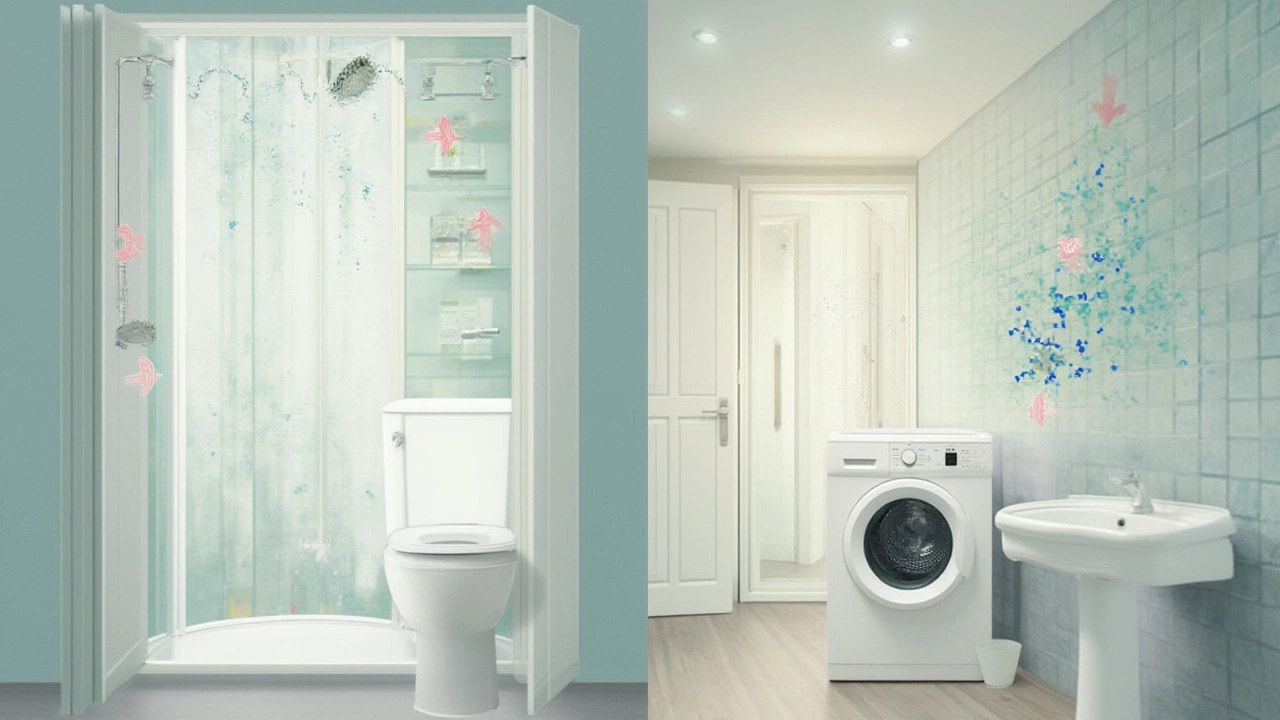Ever walked into a room and instantly felt the air was heavy, stuffy, or just plain uncomfortable? Most of us have, and it gets you thinking about what’s working behind the scenes to keep air moving—or not moving—around your home. Fans aren’t just something you ignore until they start making weird noises. They’re the unsung heroes of modern comfort. But here’s where it gets confusing: people throw around the terms “ventilation fan” and “extractor fan” like they mean the same thing. Spoiler alert—they don’t. Knowing the difference can save you money, prevent mold, and even spare you from those infamous soggy bathroom walls. Welcome to the wild and surprisingly important world of home airflow.
What Actually Is a Ventilation Fan?
Time to clear the air about ventilation fans. When you hear "ventilation fan," think big-picture. This kind of fan is designed to move air into, out of, or through an enclosed area to promote better air quality. You’ll find them everywhere—from home bathrooms, kitchens, and basements to big commercial spaces like restaurants and barns. But there’s more under the hood than just spinning blades.
The main job of a ventilation fan is to keep air fresh, which it does either by pulling in cleaner outdoor air or pushing out stale, humid, or contaminated indoor air. Some models even do both at once. These fans come built into windows, ceilings, walls, or as a part of HVAC systems. Styles vary: ceiling fans in living rooms technically circulate air, but true ventilation fans exchange it for fresh air, fighting off things like condensation, cooking smells, and those mysterious "house scents" that nobody wants to talk about.
What makes a ventilation fan tick? Most use an electric motor that spins vanes or blades, drawing air through a grille or vent. Depending on the setup, the air might be pushed out via ductwork or simply pass through a window or vented opening. Some have advanced features like humidity sensors, timers, or even Wi-Fi controls. A neat example—the Panasonic WhisperCeiling, popular for its near-silent operation, delivers not just airflow but peace and quiet.
When it comes to benefits, ventilation fans help avoid problems like mold, damp, and mildew by controlling moisture. They’re also essential in homes with poor natural airflow, bringing in needed oxygen and pushing out stuff you definitely don’t want to breathe. Want to make your home energy efficient? Proper ventilation is key because it works with your heating and cooling—not against them. Well-chosen fans prevent your AC from working overtime by keeping the temperature and humidity in check. If you’re health-conscious or allergic to dust and pollen, ventilation fans with proper filters can make a serious difference in daily comfort.
Since 2021, building codes in many countries have called for better airflow in homes and offices, meaning ventilation fans are now part of the must-have package. In short, if you’re looking to make sure everyone breathes easy—and your building stays healthy—ventilation fans are your front-line defense.
Extractor Fans: Targeted Problem Solvers
Now, let’s shift gears and talk extractor fans. These guys aren’t trying to help the whole house—they’re more like specialized SWAT teams for air problems. An extractor fan is all about removal, plain and simple. Their main job: pull unwanted air, moisture, fumes, or smoke from a specific area and toss it outside.
Extractor fans usually show up in kitchens, bathrooms, workshops, laundry rooms, or anywhere fumes and moisture pile up fast. The most classic example is the kitchen range hood (also called a vent hood) sitting above your stove, sucking up steam, grease, and odors, then venting them far away—so you don’t fill your entire house with the scent of last night’s curry. In bathrooms, these fans deal with humidity from showers so you’re not stuck with steamy mirrors and peeling paint.
The heart of every extractor fan is the motorized blade, just like with ventilation fans. The main twist is that extractor fans almost always remove indoor air to the outside, and rarely bring anything in. The journey might go straight outdoors or through a set of ducts. Some kitchen extractor units even feature charcoal filters to trap odors if venting outside isn’t possible, but that’s not quite as effective as a direct outdoor vent.
There are a few models you’ve probably seen—ceiling-mounted extractors for bathrooms, wall-mounted ones for laundry rooms, window-mounted types perfect for apartments, and under-cabinet fans over stoves. Some even kick on automatically when they sense moisture or run on timers to dry out spaces long after you’ve left the room. Check out brands like Broan and Air King if you ever go fan shopping; these guys specialize in everything from standard extractors to super-quiet premium models.
Extractor fans are often required by local building codes if a room doesn’t have a window, but plenty of people install them anyway to handle excess heat or persistent odors. They’re brilliant at stopping paint from peeling, keeping tile grout intact, and making sure your home stays comfortable and safe. Trust me—nobody wants their first hint of mildew to arrive as a funny smell in the bathroom.

Major Differences: How Ventilation and Extractor Fans Stack Up
Everyone loves a showdown, right? If you’re trying to pick the right fan, you need to know what makes them different—not just what they have in common. Here’s the trick: it’s all about what each fan is designed to do and where they shine most.
Ventilation fan is a general term covering any fan that helps introduce or move air around an area. This means it could bring in outdoor air, push stale air out, or just circulate what’s already there. Think of it as an “air manager”—always looking for balance, comfort, and freshness across large or confined spaces. These fans can either be standalone or integrated into complex HVAC systems, and in some cases, they even include filters to improve air quality further.
Extractor fans, on the other hand, only have one job: get rid of specific unwanted air right when and where you don’t want it. They’re super-focused. Unlike ventilation fans, they’re not about balance—they evacuate, period. Ventilation can be passive or active, but extractor fans are always "active." They create negative pressure, sucking air out so nasties like humidity, odors, or fumes can be sent packing. While a ventilation fan could run in a living room all day to maintain general air quality, an extractor fan kicks into gear during a hot shower or heavy cooking session, then shuts off once the job’s done.
Here’s another way to break it down: if you want to breathe better in your whole house, install a ventilation fan. If you hate steamy mirrors or smoky kitchens, grab an extractor fan. Sometimes, a single fan can cover both roles, but they’re designed with different intentions. The fan type you pick sets the tone for energy use, installation effort, and daily comfort.
- Airflow direction: Ventilation fans can work both ways (in or out). Extractor fans mostly blow air out.
- Purpose: Ventilation means long-term comfort; extracting means short-term, high-powered removal.
- Common locations: Ventilation fans go in any room that needs fresh air. Extractor fans focus on bathrooms, kitchens, or workshops.
- Operation: Ventilation fans may run constantly, especially with air systems. Extractor fans typically run on demand.
- Design: Extractor fans often need ducts to get air outside. Some ventilation fans don’t require them.
There are hybrid designs out there—smart fans that can operate as regular ventilators but also ramp up during heavy use, like Panasonic’s Intelli-Balance ERV for high-efficiency homes. Still, most people will deal with either type rather than both in most rooms.
Choosing The Right Fan: Tips and Real-World Scenarios
So how do you decide which fan is right for your home or workspace? It’s easier once you nail down your needs. First, ask yourself: What problem are you actually trying to solve? If you’re worried about everyday air quality, odors drifting from the hallway, or stuffiness, a ventilation fan is the sensible choice. But if you’re contending with thick steam every time someone showers, or kitchen smoke sets off alarms, get an extractor fan made for high-intensity work.
Want a tip? Check out the “CFM” rating on any fan you buy. That stands for Cubic Feet per Minute and tells you how much air the fan can move. Bathrooms usually need something in the 50–110 CFM range, while kitchens often require a lot more (at least 200–400 CFM for range hoods). If your bathroom regularly feels wet or smells linger, your existing fan may just be too weak for the job. And don’t overlook the sone rating—it measures how noisy the fan is. No one wants a screeching sound blaring every time they turn on the light.
Installation matters, too. If you’re a DIY type, window and wall fans are way easier than ceiling models tied to ductwork. Extractor fans with self-closing, humidity-sensing switches are great for forgetful types (we’ve all walked out mid-shower without switching the fan on). For kitchens without a direct way to the outdoors, consider a fan with a recirculating carbon filter, though expect to change those filters every few months for top performance.
Energy efficiency is another hot topic. Modern ventilation fans—especially those with ECM (Electronically Commutated Motor) technology—run quieter, use less electricity, and last longer than their noisy metal predecessors. Smart home setups can even trigger fans based on occupancy or air quality, making sure you’re not burning power unnecessarily. Look for the ENERGY STAR label if you care about long-term savings. And for allergy sufferers, models with HEPA-grade filters and sealed components can keep pollen, dust, and even wildfire smoke at bay.
Battling mold, frequent allergies, or that classic musty smell? Sometimes the real trick is combining both fans with windows and doors for maximum effect. But don’t overdo it—too much suction can backdraft appliances or pull outdoor humidity in, especially in older homes that aren’t airtight. It helps to ask a local pro, especially if you have a tricky floor plan or want to wire fans into smart switches. Get the sizing, power, and placement right, and you’ll almost forget those humid, sticky days ever happened.

